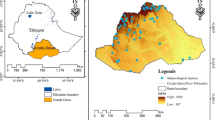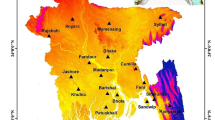Abstract
This study intended to analyze the rainfall trends for seasonal (pre-monsoon, monsoon, post-monsoon, winter) and annual rainfall from 1980 to 2021 for the small homogenous region of Malda district in West Bengal, India using Mann-Kendall (MK), Modified Mann-Kendall (MMK), Pre-Whitening Mann-Kendall (PWMK), Trend-Free Pre-Whitening Mann-Kendall (TFPWMK), and the Innovative Trend Analysis (ITA). For attaining an unbiased result different trend detection approaches were compared in this study. To determine rainfall variability, the Coefficient of variation (CV) was calculated, and the Rainfall Variability Index (RVI) was used to standardize the rainfall departure. The outcomes of the MK test demonstrated that out of a total of 45 series 13 series showed significant trends out of which 12 series had significant negative trends at 90% to 99% significance level. As per the results of MMK, 14 series exhibited significant trends out of which 13 series had significant negative trends at 90–99% significance level. Only 11 series in PWMK showed significant trends with 10 significantly negative trends at 90–99% significance level. In the TFPWMK test, 14 series showed significant trends with 11 series had significant negative trends at 90–99% significance level. As per ITA result, 36 series had significant trends out of which 11 were positively significant at a significance level of 99% and 25 series had negative trends at 90–99% significance level. Based on the results of the comparative techniques the ITA test seemed to be the best performing technique for the study area. The results of the CV showed that the maximum rainfall variations occurred in winter and annual rainfall. The RI revealed that the post-monsoon period experienced the highest number of negative departures of rainfall. The results of this study may help local and regional administrators to understand the risk of climate change and variability in this homogenous region.
Graphical abstract


















Similar content being viewed by others
Data Availability
All the data are which are evaluated during this study are included in this manuscript.
References
Asfaw A, Simane B, Hassen A, Bantider A (2018) Variability and time series trend analysis of rainfall and temperature in northcentral Ethiopia : a case study in Woleka sub-basin. Weather Clim Extrem 19(June 2017):29–41. https://doi.org/10.1016/j.wace.2017.12.002
Azam M, Maeng SJ, Kim HS, Lee SW, Lee JE (2018) Spatial and temporal trend analysis of precipitation and drought in South Korea. Water (Switzerland) 10(6). https://doi.org/10.3390/w10060765
Byakatonda J, Parida BP, Kenabatho PK, Moalafhi DB (2018) Analysis of rainfall and temperature time series to detect long-term CLimatic trends and variability over semi-arid. J Earth Syst Sci 127(2):1–20. https://doi.org/10.1007/s12040-018-0926-3
Caloiero T (2020) Evaluation of rainfall trends in the South Island of New Zealand through the innovative trend analysis (ITA). Theor Appl Climatol 139(1–2):493–504. https://doi.org/10.1007/s00704-019-02988-5
Caloiero T, Coscarelli R, Ferrari E (2018) Application of the innovative trend analysis method for the trend analysis of rainfall anomalies in southern Italy. Water Resour Manag 32(15):4971–4983. https://doi.org/10.1007/s11269-018-2117-z
Cui L, Wang L, Lai Z, Tian Q, Liu W, Li J (2017) Innovative trend analysis of annual and seasonal air temperature and rainfall in the Yangtze River basin, China during 1960-2015. J Atmos Sol Terr Phys 164:48–59
Das J, Mandal T, Rahman ATMS, Saha P (2021) Spatio-temporal characterization of rainfall in Bangladesh: an innovative trend and discrete wavelet transformation approaches. Theor Appl Climatol 143(3–4):1557–1579. https://doi.org/10.1007/s00704-020-03508-6
Farrokhi A, Farzin S, Mousavi SF (2020) A new framework for evaluation of rainfall temporal variability through principal component analysis, hybrid adaptive neuro-fuzzy inference system, and innovative trend analysis methodology. Water Resour Manag34:3363–3385
Gajbhiye S, Meshram C, Mirabbasi R, Sharma S (2016) Trend analysis of rainfall time series for Sindh river basin in India. Theor Appl Climatol 125(3–4):593–608. https://doi.org/10.1007/s00704-015-1529-4
Gedefaw M, Yan D, Wang H, Qin T, Girma A, Abiyu A, Dorjsuren B (2018) Innovative trend analysis of annual and seasonal rainfall variability in Amhara Regional State, Ethiopia. Atmosphere 9(9):326. https://doi.org/10.3390/atmos9090326
Ghosh A, Kar SK (2018) Application of analytical hierarchy process ( AHP ) for flood risk assessment : a case study in Malda district of West. Nat Hazards 94(1):349–368. https://doi.org/10.1007/s11069-018-3392-y
IPCC (2022) Climate change 2022 - mitigation of climate change - full report. Cambridge University Press (Issue 1)
Jonah K, Wen W, Shahid S, Ali A, Bilal M, Asmerom B, Iyakaremye V, Qiu Z (2021) Journal of Atmospheric and Solar-Terrestrial Physics Spatiotemporal variability of rainfall trends and influencing factors in Rwanda. J Atmos Sol Terr Phys 219(March):105631. https://doi.org/10.1016/j.jastp.2021.105631
Khaled H, Hamed A, Rao Ramachandra (1998) A modified Mann-Kendall trend test for autocorrelated data. J Hydrol 204(1–4):182–196. https://doi.org/10.1016/S0022-1694(97)00125-X
Kumar A, Giri RK, Kumar A, Kumar A (2021) Remote sensing applications : society and environment rainfall trend, variability and changes over the state of Punjab, India 1981 – 2020 : A geospatial approach. Remote Sens Appl: Soc Environ 23(July):100595. https://doi.org/10.1016/j.rsase.2021.100595
Kundu S, Khare D, Mondal A, Mishra PK (2015) Analysis of spatial and temporal variation in rainfall trend of Madhya Pradesh, India (1901–2011). Environ Earth Sci 73(12):8197–8216. https://doi.org/10.1007/s12665-014-3978-y
Malik A, Kumar A (2020) Spatio-temporal trend analysis of rainfall using parametric and non-parametric tests: case study in Uttarakhand, India. Theor Appl Climatol 140(1–2):183–207. https://doi.org/10.1007/s00704-019-03080-8
Malik A, Kumar A, Guhathakurta P, Kisi O (2019) Spatial-temporal trend analysis of seasonal and annual rainfall (1966–2015) using innovative trend analysis method with significance test. Arab J Geosci 12(10). https://doi.org/10.1007/s12517-019-4454-5
Malik D, Singh KK (2019) Rainfall trend analysis of various districts of Haryana, India. In: Lecture Notes in Civil Engineering, vol 30. Springer, Singapore. https://doi.org/10.1007/978-981-13-6717-5_10
Mallick J, Talukdar S, Alsubih M, Salam R, Ahmed M, Kahla NB, Shamimuzzaman, (2021) Analysing the trend of rainfall in Asir region of Saudi Arabia using the family of Mann-Kendall tests, innovative trend analysis, and detrended fluctuation analysis. Theor Appl Climatol 143(1–2):823–841. https://doi.org/10.1007/s00704-020-03448-1
Mondal A, Khare D, Kundu S (2015) Spatial and temporal analysis of rainfall and temperature trend of India. Theor Appl Climatol 122(1–2):143–158. https://doi.org/10.1007/s00704-014-1283-z
Mullick MRA, Nur MRM, Alam MJ, Islam KMA (2019) Observed trends in temperature and rainfall in Bangladesh using pre-whitening approach. Glob Planet Chang 172:104–113. https://doi.org/10.1016/j.gloplacha.2018.10.001
Oguntunde PG, Abiodun BJ, Lischeid G (2011) Rainfall trends in Nigeria , 1901 – 2000. J Hydrol 411(3–4):207–218. https://doi.org/10.1016/j.jhydrol.2011.09.037
Patakamuri SK, Das B (2019) Package ‘trendchange’. CRAN
Patakamuri SK, O’Brien N, Patakamuri MSK (2017) Package ‘modifiedmk’
Piyoosh AK, Ghosh SK (2016) Effect of autocorrelation on temporal trends in rainfall in a valley region at the foothills of Indian Himalayas. Stoch Env Res Risk A 2014. https://doi.org/10.1007/s00477-016-1347-y
Sanikhani H, Kisi O, Mirabbasi R, Meshram SG (2018) Trend analysis of rainfall pattern over the Central India during 1901–2010. Arab J Geosci 11. https://doi.org/10.1007/s12517-018-3800-3
Sarkar D, Sarkar T, Saha S, Mondal P (2021) Compiling non-parametric tests along with CA-ANN model for precipitation trends and variability analysis : a case study of Eastern India. Water CyCLe 2(June):71–84. https://doi.org/10.1016/j.watcyc.2021.11.002
Sayemuzzaman M, Jha MK (2014) Seasonal and annual precipitation time series trend analysis in. Atmos Res 137:183–194. https://doi.org/10.1016/j.atmosres.2013.10.012
Seenu PZ, Jayakumar KV (2021) Comparative study of innovative trend analysis technique with Mann-Kendall tests for extreme rainfall. Arab J Geosci 14(7):1–15. https://doi.org/10.1007/s12517-021-06906-w
Sen PK (1968) Estimates of the regression coefficient based on Kendall’s TAU. J Am Stat Assoc 63(324):1379–1389
Şen Z (2012) An innovative trend analysis methodology. J Hydrol Eng 17(9):1042–1046
Şen Z (2017) Innovative trend significance test and applications. Theor Appl Climatol 127:939–947
Singh RN, Sah S, Das B, Vishnoi L, Pathak H (2021) Spatio-temporal trends and variability of rainfall in Maharashtra, India: Analysis of 118 years. Theor Appl Climatol 143(3–4):883–900. https://doi.org/10.1007/s00704-020-03452-5
Storch H (1995) Misuses of statistical analysis in climate research. In: von Storch H et al (eds) Analysis of climate variability. Springer, Berlin, Heidelberg
Taxak AK, Murumkar AR, Arya DS (2014) Long term spatial and temporal rainfall trends and homogeneity analysis in Wainganga basin , Central India. Weather CLim Extrem 4:50–61. https://doi.org/10.1016/j.wace.2014.04.005
Villafuerte MQ, Matsumoto J, Akasaka I, Takahashi HG, Kubota H, Cinco TA (2014) Long-term trends and variability of rainfall extremes in the Philippines. Atmos Res 137:1–13. https://doi.org/10.1016/j.atmosres.2013.09.021
Wang Y, Xu Y, Tabari H, Wang J, Wang Q, Song S, Hu Z (2020) Innovative trend analysis of annual and seasonal rainfall in the Yangtze River Delta, eastern China. Atmos Res 231:104673
Wimhurst JJ, Greene JS (2021) Updated analysis of gauge-based rainfall patterns over the western tropical Pacific Ocean. Weather Clim Extrem 32:100319. https://doi.org/10.1016/j.wace.2021.100319
Yue S, Wang CY (2002a) Applicability of prewhitening to eliminate the influence of serial correlation on the Mann-Kendall test. Water Resour Res 38(6):4-1-4–7. https://doi.org/10.1029/2001wr000861
Yue S, Wang CY (2002b) Regional streamflow trend detection with consideration of both temporal and spatial correlation. Int J Climatol 22:933e946
Yue S, Wang CY (2002c) Applicability of prewhitening to eliminate the influence of serial correlation on the Mann-Kendall test. Water Resour Res 38(6):4-1-4–7. https://doi.org/10.1029/2001wr000861
Yue S, Pilon P, Phinney B (2003) Canadian streamflow trend detection: impacts of serial and cross-correlation. Hydrol Sci J 48:51–63. https://doi.org/10.1623/hysj.48.1.51.43478
Zhang X, Harvey KD, Hogg WD, Yuzyk TR (2001) Trends in Canadian streamflow Abstract . This study presents trends computed for the past 30-50 years for 11 hydroCLimatic variables obtained from the recently created Canadian Reference part of the country. Monthly mean streamflow for most months also d. Water Resour 37(4):987–998
Zhou Z, Wang L, Lin A, Zhang M, Niu Z (2018) Innovative trend analysis of solar radiation in China during 1962–2015. Renew Energy 119:675–689. https://doi.org/10.1016/j.renene.2017.12.052
Acknowledgements
We are thankful to Mr. Kamakhya Bose (Office of Deputy Director of Agriculture (Administration), Malda district, Govt. in West Bengal) to provide rainfall data.
Author information
Authors and Affiliations
Corresponding author
Ethics declarations
Conflict of interest
The authors declare no competing interests.
Additional information
Responsible Editor: Zhihua Zhang
Supplementary information
Rights and permissions
Springer Nature or its licensor (e.g. a society or other partner) holds exclusive rights to this article under a publishing agreement with the author(s) or other rightsholder(s); author self-archiving of the accepted manuscript version of this article is solely governed by the terms of such publishing agreement and applicable law.
About this article
Cite this article
Roy, T., Lepcha, K. Analysis of rainfall variability and trend in a small homogenous region of West Bengal in Malda district. Arab J Geosci 16, 595 (2023). https://doi.org/10.1007/s12517-023-11697-3
Received:
Accepted:
Published:
DOI: https://doi.org/10.1007/s12517-023-11697-3




